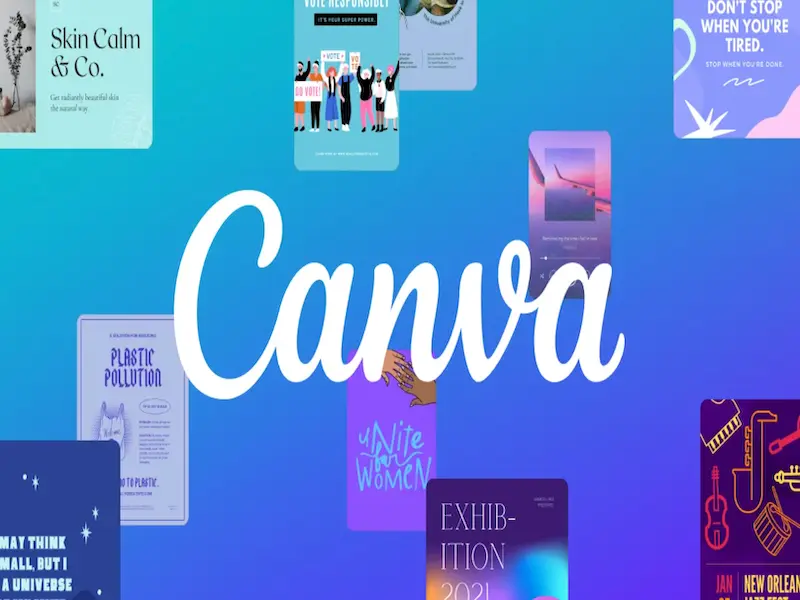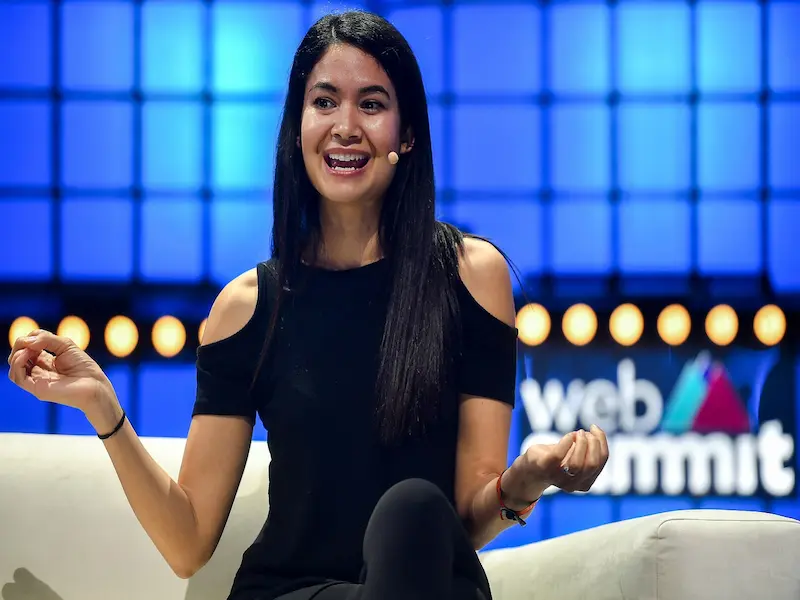- Melanie Perkins is an Australian technology entrepreneur, who is the co-founder and chief executive officer of Canva.
- Her journey from a university student frustrated by complex design software to the CEO of a multi-billion-dollar company is a testament to the transformative power of a simple idea executed with passion and determination.
OUR TAKE
Melanie Perkins is an Australian entrepreneur best known as the co-founder and CEO of Canva, a user-friendly graphic design platform. Born in 1987 in Perth, Australia, Perkins developed the idea for Canva while still a student, aiming to simplify the process of design for everyone, regardless of their technical skills. Under her leadership, Canva has grown into a multi-billion-dollar company, democratising design tools for individuals and businesses worldwide.
–Jennifer Yu, BTW reporter
Early life and education
“When I was 14, I started my first business creating handmade scarves that I sold at shops and markets throughout Perth, and I never forgot the freedom and excitement of being able to build a business. That was one of the driving forces that led me to launch what would evolve to be Canva.”
Melanie Perkins, founder of Canva
Melanie Perkins was born in Perth, Western Australia in 1987. Her father is an Australian teacher, and her mother is a Malaysian engineer. In high school, Perkins aspired to be a professional figure skater and often got up at 4 am to train. At the age of fourteen, she started her first business.
“When I was 14, I started my first business creating handmade scarves that I sold at shops and markets throughout Perth, and I never forgot the freedom and excitement of being able to build a business. That was one of the driving forces that led me to launch what would evolve to be Canva,” she said.
The birth of an idea
After high school, Perkins enrolled at The University of Western Australia, majoring in communications, psychology and commerce. At the same time, Perkins taught students how to use design software like Adobe Photoshop and InDesign. She quickly realised that many students struggled with the complexity of these tools, which required significant time and effort to master. This observation struck a chord with Perkins, who wondered why design had to be so difficult. Why couldn’t there be a tool that made design accessible to everyone, regardless of their technical skills?
This question became the seed for what would eventually grow into Canva. Perkins believed that design should be simple, intuitive, and accessible to all. She envisioned a tool that would allow anyone to create professional-quality graphics without the need for extensive training or expensive software. However, turning this idea into reality was no small feat.
Also read: Canva strengthens design offerings through acquisition of Leonardo AI
The “Fusion Books” experiment
“My mum’s living room became my office, and my boyfriend became my business partner, and we started enabling schools to create their yearbooks really, really simply.”
Melanie Perkins, founder of Canva
Before Canva, there was Fusion Books. In 2007, while still a student, Perkins co-founded Fusion Books with her then-boyfriend (now husband) Cliff Obrecht. Fusion Books was an online tool that allowed students and schools to create their own yearbooks. The platform provided a simple, drag-and-drop interface where users could customise templates, add photos, and edit text to create a polished yearbook. This venture was Perkins’ first foray into the world of entrepreneurship and digital design.
“My mum’s living room became my office, and my boyfriend became my business partner, and we started enabling schools to create their yearbooks really, really simply,” Perkins told CNBC.
Fusion Books was a success, becoming the largest yearbook publisher in Australia and expanding into France and New Zealand. However, more than just a profitable business, Fusion Books was a learning ground for Perkins. It taught her valuable lessons about product development, user experience, and the challenges of scaling a tech company. Most importantly, it reinforced her belief that there was a significant demand for accessible design tools.
Also read: Aespa’s merging of AI and reality points to the future of entertainment
Founding Canva
With the success of Fusion Books under her belt, Perkins was ready to tackle a bigger challenge. She knew that the problem of inaccessible design tools was not limited to yearbooks—it was a global issue affecting businesses, educators, marketers, and individuals across various industries. In 2012, together with Obrecht and Cameron Adams, a former Google engineer, Perkins founded Canva.
A few months later, at the close of their first round of funding, the company was oversubscribed. The Australian government even provided the company with an initial investment of $1.5 million to ensure the company stayed in Australia. The following year, the site went live, allowing subscribers to create a variety of online designs for free.
Canva was launched with a clear mission: to democratise design and empower anyone to create beautiful content. The platform was designed to be incredibly user-friendly, with a drag-and-drop interface and a vast library of templates, images, and fonts. Whether you were creating a social media post, a presentation, a flyer, or a business card, Canva made the process simple and enjoyable.

The rapid rise of Canva
Under Perkins’ leadership, Canva experienced rapid growth. By 2014, just two years after its launch, the platform had over one million users.
This growth was driven by word-of-mouth, as satisfied users recommended Canva to their friends and colleagues. The platform’s freemium model, where users could access basic features for free and pay for premium elements, also contributed to its widespread adoption.
Canva’s success attracted the attention of investors, and the company raised several rounds of funding, allowing it to expand its team and enhance its product offerings. By 2018, Canva had reached a valuation of over one billion dollars, making it a tech unicorn. Perkins, who was just 31 at the time, became one of the youngest female CEOs to lead a billion-dollar company.
Despite its rapid growth, Canva remained true to its core mission. The company continued to focus on making design accessible to everyone, constantly adding new features and tools to meet the evolving needs of its users. Today, Canva offers a wide range of products, including tools for creating videos, presentations, websites, and more. The platform has over 130 million active users in more than 190 countries, making it one of the most popular design tools in the world.
Pop quiz:
Which of the following is the correct description?
a. Before Canva, Perkins started her first venture “Fusion Books”
b. The Australian government provide $3 million initial investment to ensure the company stayed in Australia
c. Two years after Canva launch, the platform had almost one million users
d. Perkins didn’t plan to start her own business until she was in college
The correct answer is at the bottom of the article.
Leadership and impact
Melanie Perkins is often praised for her leadership style, which is both visionary and inclusive. As a young female CEO in a male-dominated industry, she has broken through many barriers, becoming a role model for aspiring women entrepreneurs. Perkins leads Canva with a clear sense of purpose: to empower people through design. This mission-driven approach is reflected in every aspect of the company, from product development to corporate culture.
“I think knowing that everyone is struggling to make things work and feels like they are on a rollercoaster and pedalling as quickly as they can, is mightily powerful.”
Melanie Perkins, founder of Canva
One of the key aspects of Perkins’ leadership is her commitment to encouraging those who often doubt themselves and are not valued. In an article she wrote, “I think it’s pretty important to know that every single person is going through their own trials and tribulations. I haven’t met a single founder, or a single person who’s working towards achieving huge goals, that have had things handed to them on a silver platter.”
“I think knowing that everyone is struggling to make things work and feels like they are on a rollercoaster and pedalling as quickly as they can, is mightily powerful,” she added. Canva’s workforce is composed of people from all over the world, and the company places a strong emphasis on ensuring that everyone feels valued and included.
Perkins is also a firm believer in work-life balance. Despite the fast-paced nature of the tech industry, she has worked to build a company where employees are encouraged to take care of their mental and physical health. Canva’s offices are designed to promote well-being, with features like meditation rooms, fitness spaces, and healthy snacks available to employees.
In addition to fostering a positive internal culture, Perkins is passionate about giving back to the community. Canva has become a certified B Corporation, meaning it meets the highest standards of social and environmental performance. Perkins has spearheaded several initiatives aimed at making a positive impact, including donating Canva’s premium features to nonprofits and educational institutions.

The future of Canva
As Canva continues to grow, Perkins has ambitious plans for the future. The platform has already expanded its offerings to include new tools like video editing, website design, and team collaboration features. Perkins envisions Canva becoming an essential tool for businesses of all sizes, helping them create not only beautiful designs but also impactful marketing campaigns, engaging presentations, and dynamic social media content.
One of Canva’s most recent developments is its push into the enterprise market. While Canva started as a tool for individuals and small businesses, it is now being adopted by large organisations, including Fortune 500 companies. The introduction of Canva for Enterprise allows teams to collaborate on designs, manage brand assets, and create custom templates, making it easier for businesses to maintain brand consistency across all their visual content.
In addition to expanding its product offerings, Canva is also focusing on international growth. The company is investing in localisation efforts to ensure that users around the world can access Canva in their native languages and tailor the platform to their specific cultural needs. The platform is already available in over 100 languages, and Perkins is committed to making Canva a truly global tool.
The correct answer is A, before Canva, Perkins started her first venture “Fusion Books”.

